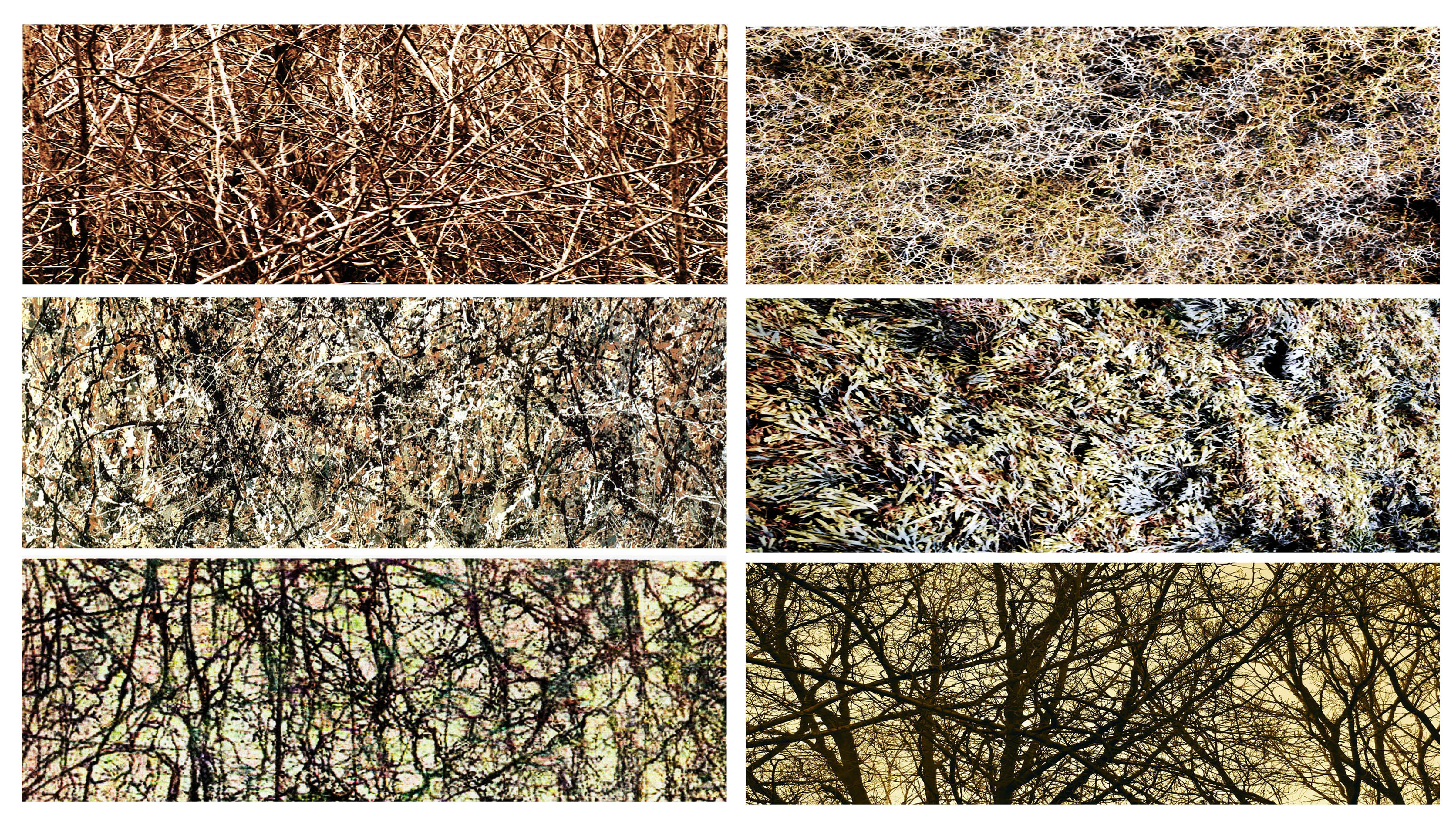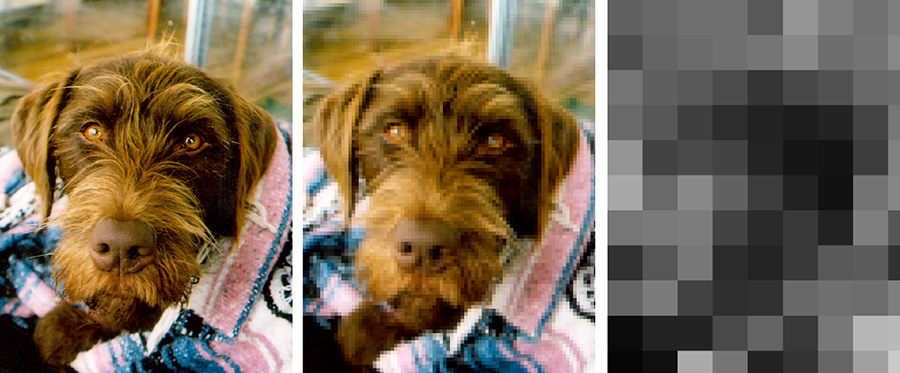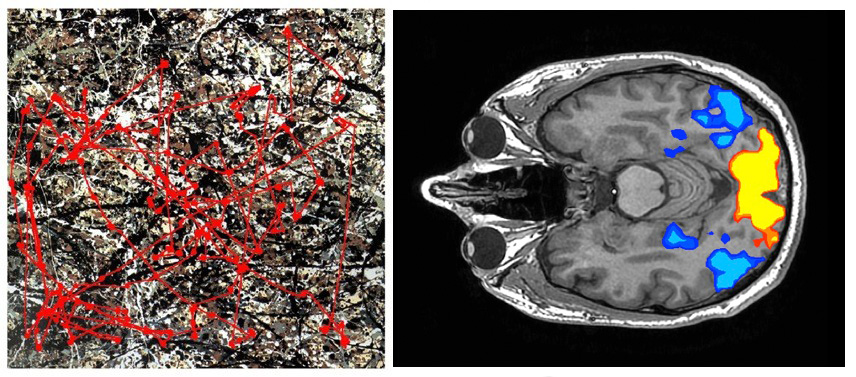 Jackson Pollock’s poured paintings are estimated to be worth up to $500M each, making them the world’s most valued paintings. There are also 350 fakes in circulation. Can you tell the masterwork from the fake (above)? We are quantifying Pollock’s fractals using a computer analysis technique called Dimensional Interplay Analysis with the aim of contributing to the authenticity process.
Jackson Pollock’s poured paintings are estimated to be worth up to $500M each, making them the world’s most valued paintings. There are also 350 fakes in circulation. Can you tell the masterwork from the fake (above)? We are quantifying Pollock’s fractals using a computer analysis technique called Dimensional Interplay Analysis with the aim of contributing to the authenticity process.
There’s a lot of misinformation on the internet regarding Pollock’s fractals. Here are the facts:
Are Jackson Pollock’s poured paintings fractal? Yes
Sophisticated neuroscience experiments (involving techniques such as eye-tracking, fMRI etc) demonstrate that the human visual system responds in the same way to Pollock’s patterns as to nature’s fractals and computer-generated fractals. If Pollocks look exactly the same as other fractals then they are fractal. If you prefer to rely on computer analysis of the patterns to answer the question, 10 independent groups have successfully quantified over 50 Pollocks using fractal parameters. As Benoit Mandelbrot, the inventor of the term fractal, summed up: “I do believe Pollocks are fractal.”
Can fractal analysis help distinguish Pollocks from other art works? Yes
The accuracy depends on factors such as image quality of the paintings, the techniques used to process the images and the fractal parameters analyzed. The most recent studies from 2015 achieved 93% accuracy.
For more details, see the below time-line for the relevant investigations and their publications:
1992: Author John Briggs published a book featuring the first observation that Jackson Pollock’s poured paintings have the appearance of fractal patterns (Fractals, Touchstone Publishers, 1992)
1997-8: Physicist Richard Taylor built a chaotic pendulum called the “Pollockizer” to generate fractal paintings using the pouring technique (Physics World, 76, November 1997, New Scientist, vol. 2144, 30, 1998 and The Art of Science documentary, ABC, May 1998)
1998: Mathematician Richard Voss conducted the first fractal analysis of an artwork. He used the analysis to distinguish between illustrative paintings by different Chinese artists (Fractal Image Encoding and Analysis, Springer, 1998)
1999: Taylor’s group published the first fractal analysis of Pollock’s paintings (Nature, vol. 399, 422, 1999. See also Scientific American, vol. 287, 116-121, 2002 and Leonardo, vol. 35, 203-207, 2002)
1999: Taylor introduced the term “Fractal Expressionism” to describe fractal art generated by humans rather than computers (Physics World, 25, October 1999)
1999: Art conservator Jim Coddington proposed that fractal analysis should be explored as a technique to help authenticate Pollock paintings
2003: Psychologist Branka Spehar collaborated with Taylor to demonstrate that Pollock’s fractals induce the same physiological responses in observers as nature’s fractals and computer-generated fractals (Chaos and Graphics, vol. 27, 813, 2003)
2004-5: Physicist Jonas Mureika’s group quantified Pollock’s fractals using a multi-fractal analysis technique (Physical Review E, vol. 72, 046101-1-15, 2005 and Chaos, vol. 15, 043702-1-6, 2005).
2005: Taylor’s group used a dimensional interplay fractal analysis to distinguish 14 authentic Pollock paintings from 51 non-Pollock paintings with 100% accuracy (Pattern Recognition Letters, vol. 28, 695-702, 2005)
2005: The Pollock-Krasner Foundation asked Taylor to perform a fractal analysis on the “Matter paintings” found in a New York storage locker (Nature, 439, 648, 2006). The analysis identified “significant deviations from Pollock’s characteristics.” Taylor cautioned that the results should be “coupled with other important information such as provenance, connoisseurship and materials analysis.” Two years later, materials scientists showed that pigments on the paintings dated from after Pollock’s death
2006: Physicist Kate Jones-Smith and colleagues published a study of non-fractal star drawings and claimed that fractal analysis is flawed because their analysis falsely identified the stars as fractal (Nature, vol. 444, E9-10, 2006). In their rebuttal, Taylor’s group performed their own fractal analysis on the star patterns and showed that the stars were, in fact, not fractal (Nature, vol. 444, E10-11, 2006). Taylor reported further flaws in Jones-Smith’s analysis. Fractals expert Lansaros Gallos summed up: “What Jones-Smith has done is just a simple trick – this is bad science about fractals.” (ScienceNews, vol. 171, 122, 2007) Jones-Smith raised one valid issue: whether Pollock’s patterns occur over enough magnifications to be called fractal. However, she admitted she was at odds with the research community. She would have to dismiss half of all the investigations of fractals ever published based on this concern. Benoit Mandelbrot, inventor of the term fractal, summarized: “I do believe Pollocks are fractal.” (ScienceNews, vol. 171, 122, 2007).
2006-7: Computer Scientist Bruce Gooch’s group used computers to generate Pollock-like images by varying their fractal characteristics (Proceedings of the 4th International Symposium on Non-Photorealistic Animation and Rendering, 97-104, 2006 and Journal of Mathematics and the Arts, vol.1, 73-83, 2007)
2007: Art theorist Claude Cernuschi’s and colleagues presented an “arc-fractal” model of Pollock’s paintings (Pollock Matters, McMullen Museum of Art, 2007)
2007: Jones-Smith and colleagues announced to the press that they had submitted a study of poured paintings to the journal Physical Review Letters. The study showed that their fractal analysis could not distinguish between Pollock and non-Pollock paintings. Physical Review Letters rejected the submission. Computer scientist Hany Farid commented: “I think they [Jones-Smith et al] took a fairly simplistic way of separating those colors [of paint] which could have skewed their results.” The study served as a useful warning: the success rate of fractal analysis in detecting fakes is sensitive to factors such as image quality of the paintings and the image processing techniques used. http://www.scientificamerican.com/article.cfm?id=can-fractals-spot-genuine.
2007-8: Three groups (led by psychologist Christoph Redies, psychologist David Field and computer scientist Jose Alvarez-Ramirez) independently quantified Pollock’s fractals using a Fourier transform technique (Spatial Vision, vol. 21, 97-117, 2007, Spatial Vision, vol. 21, 137-148, 2007, Journal of Spatial Vision, vol. 21, 149-164, 2007, Perception, vol. 37, 1341-1352, 2008, Physica A, vol. 387, 281-295, 2008).
2008: Alvarez-Ramirez quantified Pollock’s fractals using Hurst analysis (Physica A, vol. 387, 6452-646, 2008)
2008: Coddington and computer scientist Dan Rockmore quantified Pollock’s fractals using entropy dimension. They summarized as follows: “Fractal geometry has begun to play an important role in the authentication of the work of Jackson Pollock. We believe such analyses are necessary for pushing the field forward” (Proceedings SPIE, vol. 6810, 68100F 1-12, 2008)
2009: Jones-Smith and colleagues’ 2007 fractal analysis of poured paintings was eventually accepted for publication (Physical Review E, vol. 79, 046111, 2009). In his own publications on Pollock’s fractals, computer scientist David Stork described Jones-Smith’s publication as: “a failure to follow well-established principles and methodologies from statistical pattern recognition” (SPIE Electronic Imaging: Machine Vision Applications II, vol. 7251, 72510Q1–11 2009 and SPIE Proceedings on Computer Vision and Image Analysis of Art II, vol. 7869, 78690H, 2009). He also recommended combining fractal analysis with other pattern analysis techniques to increase its detection capabilities.
2010: Mureika and Taylor used fractal analysis to successfully distinguish between poured paintings by adults and children (SPIE Proceedings of Electronic Imaging, vol. 7531, 7531001-6, 2010)
2011: Taylor and neuroscience collaborators developed a “fractal fluency” model for how observers view Pollock’s fractals. The results demonstrated that Pollock’s patterns span sufficient magnifications to strongly display the visual character of fractals (Frontiers in Human Neuroscience, vol. 5, 1- 13, 2011 and Fractal Geometry of the Brain, Springer, 2016).
2011: Cernuschi’s group employed non-linear physics to examine Pollock’s pouring technique (Physics Today, June edition, 31-36, 2011).
2012: In a public lecture on Pollock, chief Pollock scholar Francis O’Connor declared “These fractal occurrences in the facture of Pollock’s pourings can be read as a very personal signature that can be found in all of his works” and described fractal analysis as a “tool with which the connoisseur can perceive falsity in a fake Pollock” https://blogs.uoregon.edu/richardtaylor/files/2015/12/FrancisOconnor-1clwmv9.pdf
2013: Mureika and Taylor quantified Pollock’s fractals using multi-fractal depth (Signal Processing, vol. 93, 573-578, 2013)
2014: Computer scientist Kang Zheng’s group used computers to generate Pollock-like images based on fractal patterns (Vis Comput
DOI 10.1007/s00371-014-0985-7)
2015: Computer scientist Lior Shamir showed that, when combined with other pattern parameters, fractal analysis can be used to distinguish between real and imitation Pollocks with 93% accuracy. He found that the fractal parameters were the most powerful contributors to the detection accuracy (International Journal of Arts and Technology, vol. 8, 1, 2015)
2016: Shamir used fractal analysis to distinguish between abstract expressionist paintings by adults and children (ACM Transactions of Applied Perception, vol. 13, 1, 2016)
2016: Physicist Elsa De la Calleja and colleagues examined the evolution of Pollock’s paintings in terms of an “Order-Fractal” transition. (Annals of Physics, Vol. 371, 313 (2016)
2017: Psychologist Alex Forseythe’s group showed that the fractal characteristics of a painting can be linked to the artist’s neurological condition (Journal of Neurophysiology, vol. 31, 1, 2017)
2017: Taylor’s group use fractal analysis to explain why Pollock’s paintings induce perceived images (PLOS ONE, DOI: 10.1371/journal.pone.0171289 Nature | News, 14th February 2017: http://www.nature.com/news/fractal-secrets-of-rorschach-s-famed-ink-blots-revealed-1.21473)
2017: De la Calleja’s group compared the evolution of the fractal characteristics in Pollock’s paintings to parameters quantifying the painting’ topology (Betti numbers) (Knowledge Based Systems, 2017)
2019: Aleverez-Ramirez employs fractal analysis to compare Pollock’s paintings to those of the Riopelle Abstract Expressionists (to be published in Physica A)





